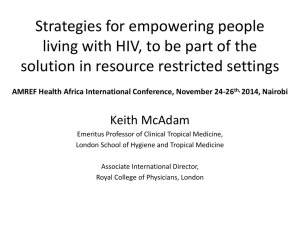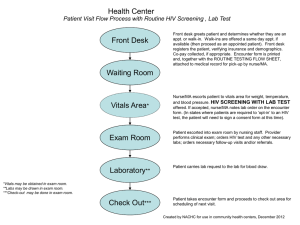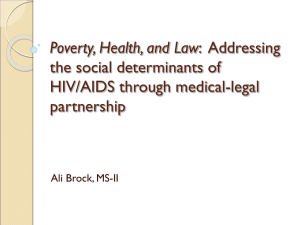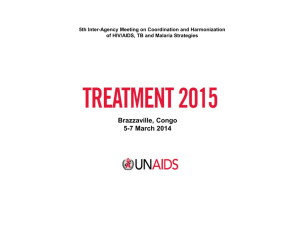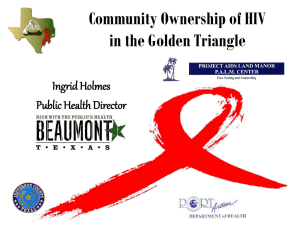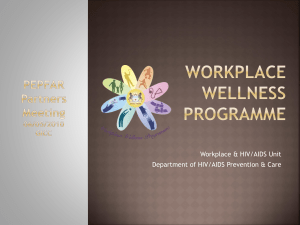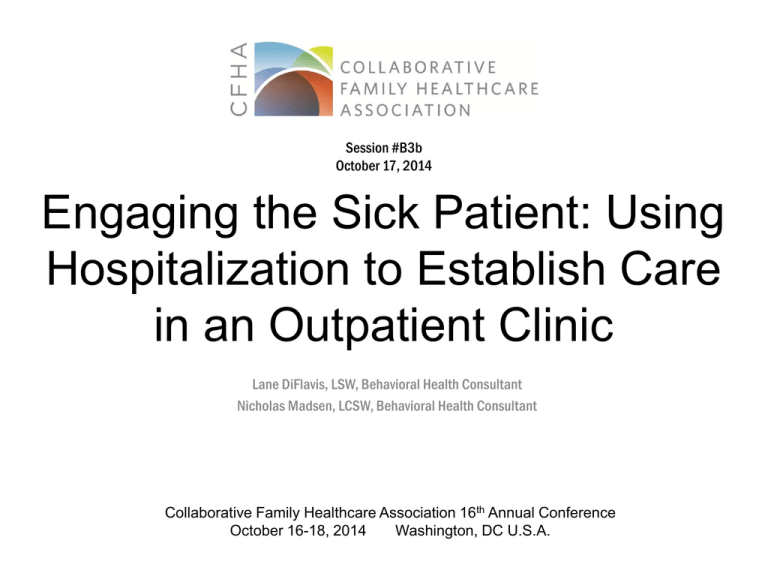
Session #B3b
October 17, 2014
Engaging the Sick Patient: Using
Hospitalization to Establish Care
in an Outpatient Clinic
Lane DiFlavis, LSW, Behavioral Health Consultant
Nicholas Madsen, LCSW, Behavioral Health Consultant
Collaborative Family Healthcare Association 16th Annual Conference
October 16-18, 2014
Washington, DC U.S.A.
Faculty Disclosure
• We have not had any relevant financial relationships
during the past 12 months.
Learning Objectives
At the conclusion of this session, the participant will be able to:
• Explore how trauma-informed interventions are
especially useful when working with HIV+ patients
• Discuss how behavioral health consultants can engage
patients while hospitalized
• Describe the benefits of establishing care during
hospitalization
• Identify potential areas of concern with this integration
Bibliography / Reference
1.
Amodio, Rachel D., “Predicting Initial Mental Health/Substance Abuse Treatment Attendance in
HIV/AIDS Patients: An Exploration of Risk Factors” (2013). PCOM Psychology Dissertations.
Paper 267.
2.
Harding, Richard, Lampe, Fiona C., Norwood, Sally, et al. “Symptoms are highly prevalent among
HIV outpatients and associated with poor adherence and unprotected sexual intercourse”
(2010). Sexually Transmitted Infections. June 2010, 86, 520–24.
3.
Lucas, Gregory M., “Substance Abuse, Adherence with Antiretroviral Therapy, and Clinical
Outcomes Among HIV-Infected Individuals” (2011). Life Science. May 2011, 88(21-22), 948-952.
4.
Merlin, Jessica S., Westfall, Andrew O., et al, “Pain, Mood, and Substance Abuse in HIV:
Implications for Clinic Visit Utilization, Antiretroviral Therapy Adherence, and Virologic Failure”
(2010). JAIDS Journal of Acquired Immune Deficiency Syndromes. October 2012, 61(2): 164170.
5.
Mugavero, Michael J., Davila, Jessica A., Nevin, Christa R., and Giordano, Thomas P., “From
Access to Engagement: Measuring Retention in Outpatient HIV Clinical Care” (2010). AIDS
Patient Care and STDs. October 2010, 24(10): 607-613.
6.
Mugavero, Michael J. et al. “Missed Visits and Mortality in Patients Establishing Initial Outpatient
HIV Treatment” (2009). Clinical Infectious Disease. January 2009, 48(2), 248-256.
Additional References
•
•
•
•
•
•
•
•
•
•
www.ptsd.va.gov
www.instituteforsafefamilies.org/philadelphia-urban-ace-study
www.phila.gov/health/aaco
www.sanctuaryweb.com
Briere, J., & Scott, C. (2006). Principles of Trauma Therapy: a Guide to Symptoms,
Evaluation, and Treatment . California: Sage Publications.
Herman, J. (1997). Trauma and Recovery: The Aftermath of Violence. NY: Basic
Books
Miller, W., & Rollnic, S. (2013), Motivational Interviewing; Third Edition: Helping
People Change. New York: Guilford Press.
Rollnic, S., Miller, W. & Butler, C. (2008), Motivational Interviewing in Healthcare:
Helping Patients Change Behavior. New York: Guilford Press.
Bloom, S. (2013), Creating Sanctuary; towards the evolution of sane societies;
revised edition. New York: Routledge.
Bloom, S. (2013), Restoring Sanctuary: a new operating system for traumainformed systems of care. New York: Routledge.
Learning Assessment
• A learning assessment is required for CE
credit.
• A question and answer period will be
conducted at the end of this presentation.
First, some background
about our project…
SAMHSA Funded Project
• Part of Twelve Cities Inter-Agency Program
– Concentrating services for HIV+ patients in cities with
largest numbers of patients
• Funded in part by all three SAMHSA Centers
• Grant awarded to Philadelphia Department of
Public Health, AIDS Activities Coordinating Office
– Collaboration of Department of Psychiatry, Drexel
College of Medicine, Mental Health Association of
Southeastern Pennsylvania, and Health Federation of
Philadelphia
– And six HIV care clinics in the city
Participating Clinics
• Partnership Comprehensive Care Practice, Drexel
College of Medicine
• MacGregor Clinic, University of Pennsylvania Medical
Center
• Infectious Disease Clinic, Penn Presbyterian Medical
Center
• HIV Comprehensive Care Clinic, Temple University
Medical Center
• Immunodeficiency Clinic, Albert Einstein Medical
Center
• Ambulatory Health Centers, Philadelphia Department
of Public Health (four clinics)
The BHC Model
• Consultation on patient “behavioral health” needs with medical
providers as requested
• Brief, focused visits with patients
–
–
–
–
Typically in medical examination rooms
15-20 minute sessions in cycle with medical providers
Typically 1 to 4 sessions per patient
Focused progress notes in the medical record or EMR
• “Low threshold” access to behavioral health care
– Eschewing the “therapist” model
• Interventions for a wide variety of needs
– Depression, anxiety, trauma, substance abuse, smoking cessation,
support for exercise, good diet, etc.
– Help with medication adherence, disclosure of HIV+ status to various
others, prevention of HIV transmission, etc.
Some Interpretations
• The BHCs have achieved very high rates of
penetration of their clinics
– In FQHCs, 25% penetration is viewed as strong and
showing effectiveness of the service
• The BHCs have higher numbers of repeat visits
with patients than BHCs at FQHCs
– Some patients have 10 or more visits
• Due to complexity of needs
• Due to challenges keeping them from engaging in formal
therapy
• The high penetration rates relate to the complex
behavioral health needs of the patients
Prominence of Support for
Medical Treatment
• Although BHCs also engage patients for classical
behavioral health issues (depression, anxiety, trauma,
relationship difficulties), a major focus of their care is
on supporting patients in engaging in medical
treatment:
–
–
–
–
–
Attendance at appointments with medical providers
Adherence to medications
Regularity in attendance and adherence
Modifying conduct to prevent transmission of HIV
Disclosing HIV status to appropriate others
• And not disclosing when perhaps inappropriate
• Disclosure – esp. to partners and family - often relates to
treatment engagement
Who are these patients?
How trauma-informed care helps us better
engage with these patients…
The Impact of Trauma on Health
Outcomes
•
•
•
•
•
•
•
•
•
Adverse Childhood Experience (ACE) Study
Emotional Abuse
Physical Abuse
Sexual Abuse
Emotional Neglect
Physical Neglect
Mother treated violently
Household Substance Abuse
Parental Separation / Divorce
Incarcerated household member
(Acestudy.org)
Cumulative Impact of Trauma:
Health Risks
Behaviors:
Outcomes
•
•
•
•
•
•
•
•
•
•
•
•
•
•
•
•
•
•
School tardiness/ truancy
Dysregulated eating
Smoking
Suicide Attempts
Substance use
Multiple Sexual Partners
Self-Injurious Behaviors
Autoimmune disorders
Obesity
Substance Abuse Disorders
COPD
Depression
Anxiety
PTSD
Liver Disease
Risk for IPV
STI’s / HIV
Unintended pregnancies
Sequelae of Adverse Childhood Experiences
Early
Death
Disease
Health Risk Behavior
Social, Emotional, Cognitive
impairment
Adverse Childhood Experience
Urban Aces: Philadelphia
Added ACES:
• Experiencing Racism
• Witnessing Violence
• Living in an unsafe neighborhood
• Experiencing bullying
Prevalence of Population with 4 / +
ACE’s
Prevalence of People living with
HIV / AIDS
Similarities
Trauma and HIV Risk Behaviors
•
•
•
•
•
•
Disrupted relationships
Psychological distress
Substance Abuse
Exchanging Sex for money, shelter, substance
Experiencing retraumatization
Difficulty navigating boundaries and condom
usage
Being Diagnosed with HIV is a
Traumatic Event
Can trigger feelings of:
• Betrayal
• Victimization
• Powerlessness
• Mortality
• Loss
• Shame
The “Difficult Patient”
• Avoidance of triggers: Medication and appointment
adherence
• Challenges in participating in care: organizing narrative
material, attentiveness and memory difficulties
• Protective behaviors that can be perceived as character
flaw rather than survival strategies
• Difficulty with affect regulation and self soothing
(disproportionate reactions)
• Aggression / Defiance
• Poor boundaries
• Avoidance, denial, or deflection
• Difficulty taking another’s perspective
Patients with PTSD and/or histories of trauma are
likely to present to primary care with some (or
many of these characteristics. Their behavior can
interfere with patient-provider communication,
impede compliance with treatment regimens, and
generally frustrate the practitioner. These patients
are at high risk for deteriorating health.
** Most trauma victims do not seek mental health
services. Instead they look for assistance and care
in the primary care setting
(www.ptsd.va.gov)
To Engage the Sick Patient we Must understand
Complex Problems
Technical Problems
• Easy to identify
• Cut and dry repetitive
solutions
• Can be implemented
quickly
• Requires relatively little
change
• Provides immediate relief
from anxiety
Adaptive Problems
• Hard to define
• Every case is different
• Often requires
considerable time and
resources
• May require significant
and uncomfortable
change
• Requires ability to
tolerate uncertainty and
risk
Humans are Adaptive
When faced with adaptive problems,
practitioners may experience anxiety, a desire to
“fix” what’s “wrong,” and are more likely to
treat the problem as technical which minimizes
the complexity of our patients experience and
decreases the likelihood of their success
When Working with The Sick Patient:
Keep in Mind…
•
•
•
•
•
•
•
•
•
Educate yourself on the impact of trauma
Be aware that trauma may be involved in our patients history
Be non-judgmental
Do not take the patients reactions, accusations, and commentary
personally– Though it may be designed to hurt you.
Offer consistency in the way that you treat them
Stay calm, attuned, present, predictable, and do not escalate.
Help Patients to identify personal triggers and plan for safety.
Support patients in identifying their own needs and utilizing
appropriate resources to address their trauma histories
Reflect on our own practice and work settings; evaluate for ways to
increase patients sense of safety and incorporate trauma informed
considerations.
Case Study
Claire is a 40 year old HIV+ African American female who had
been referred to the BHC due to recurrent hospitalizations
(Pneumocystis pneumonia) as a result of her compromised
immune system and non-adherence. Her lab work indicated a
CD4 count of 37 and a viral load of 87,400. Claire had been
linked to our care but had missed all 11 of her scheduled
appointments. She had been diagnosed with HIV since 2004
and had maintained adherence to HAART until the death of
her mother in 2008, whom she identified as her only support.
Claire has a history of childhood sexual assault, witnessing
violence / household IPV, living in an unsafe
neighborhood/chronic poverty, incarcerated family member,
history of substance abuse, and experiencing racism.
Initial contact
BHC made contact with Claire during one of her
inpatient hospitalizations after having missed 11
scheduled appointments to the clinic. She
presented initially as agitated and defensive and
reported that her primary barrier to attending her
medical appointments was lack of car fare. Upon
further assessment, Claire was able to open up
about her struggle with her HIV diagnosis and the
onset of depression following the loss of her
mother– who used to take her to her medical
appointments. Claire attended her following
medical appointment.
Session Evaluation
Please complete and return the
evaluation form to the classroom monitor
before leaving this session.
Thank you!

